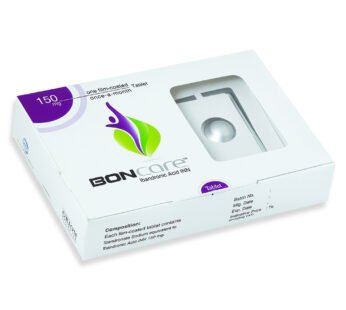Bonizol 5 mg/100 ml
Description
Indications:
Bonizol is indicated for:
- Treatment and prevention of postmenopausal osteoporosis.
- Increasing bone mass in men with osteoporosis.
- Treatment and prevention of glucocorticoid-induced osteoporosis.
- Treatment of Paget’s disease of bone in men and women.
Limitations of Use: The optimal duration of use has not been determined. For patients at low risk of fracture, consider discontinuation after 3 to 5 years of use.
Always consult a registered physician before use.
Pharmacology:
Bonizol contains Zoledronic Acid, a bisphosphonate that inhibits osteoclast-mediated bone resorption. It binds to mineralized bone with high affinity, particularly at sites of high bone turnover. The drug targets the enzyme farnesyl pyrophosphate synthase in osteoclasts, leading to a long duration of action due to its strong binding to bone mineral.
Dosage:
- Postmenopausal Osteoporosis (Treatment):
- 5 mg intravenous infusion once a year over at least 15 minutes.
- Postmenopausal Osteoporosis (Prevention):
- 5 mg intravenous infusion once every 2 years over at least 15 minutes.
- Osteoporosis in Men:
- 5 mg intravenous infusion once a year over at least 15 minutes.
- Glucocorticoid-Induced Osteoporosis:
- 5 mg intravenous infusion once a year over at least 15 minutes.
- Paget’s Disease of Bone:
- 5 mg intravenous infusion over at least 15 minutes. Re-treatment may be considered based on serum alkaline phosphatase levels or symptoms.
Calcium and Vitamin D Supplementation:
- Paget’s Disease: Patients should take 1500 mg elemental calcium daily and 800 IU vitamin D daily, especially in the 2 weeks following Bonizol administration.
- Osteoporosis: Patients should ensure adequate dietary intake of calcium (1200 mg daily) and vitamin D (800–1000 IU daily).
Administration:
- Administer as an intravenous infusion over no less than 15 minutes.
- Ensure patients are adequately hydrated before administration.
- Inspect the solution for particulate matter or discoloration before use.
- Follow the infusion with a 10 mL normal saline flush.
- Do not mix with calcium-containing solutions. Administer through a separate infusion line.
- If refrigerated, allow the solution to reach room temperature before use.
Contraindications:
- Hypocalcemia.
- Severe renal impairment (creatinine clearance <35 mL/min).
- Hypersensitivity to Zoledronic Acid or any component.
Side Effects:
- Common: Fever, muscle pain, headache, joint pain, limb pain.
- Serious: Flu-like symptoms, nausea, vomiting, diarrhea, eye inflammation, osteonecrosis of the jaw, atypical femur fractures.
Precautions and Warnings:
- Monitor serum calcium, phosphate, and magnesium levels. Supplement as needed.
- Assess renal function before each dose. Avoid use in severe renal impairment.
- Perform routine oral exams to monitor for osteonecrosis of the jaw.
- Evaluate patients with thigh or groin pain for atypical femur fractures.
- Discontinue use if severe bone, joint, or muscle pain occurs.
Drug Interactions:
- Aminoglycosides: May prolong hypocalcemia.
- Loop Diuretics: May increase the risk of hypocalcemia.
- Nephrotoxic Drugs: Use with caution. Monitor renal function.
Overdose:
- Symptoms may include hypocalcemia, hypophosphatemia, and hypomagnesemia. Treat with intravenous calcium gluconate, potassium/sodium phosphate, or magnesium sulfate as needed.
Use in Special Populations:
- Pediatric Use: Not indicated for children.
- Geriatric Use: Monitor renal function closely.
- Renal Impairment: Contraindicated in severe renal impairment (creatinine clearance <35 mL/min).
- Hepatic Impairment: No dosage adjustment required.
Storage Conditions:
Store below 30°C in a dry place, protected from light and moisture. Keep out of children’s reach.
Additional information
| Weight | 0.5 g |
|---|








Reviews
There are no reviews yet.